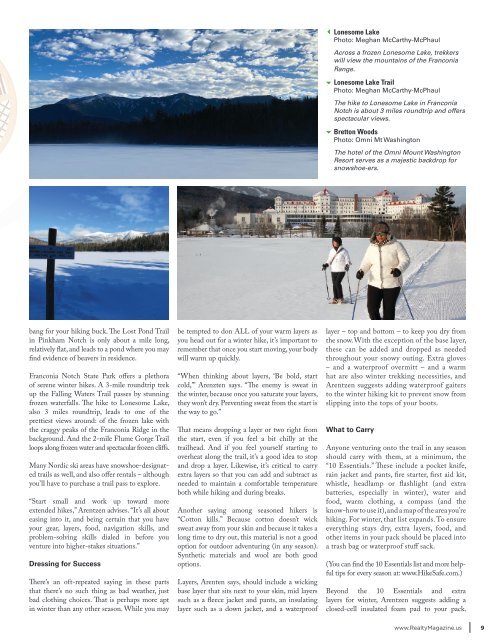You also want an ePaper? Increase the reach of your titles
YUMPU automatically turns print PDFs into web optimized ePapers that Google loves.
Lonesome Lake<br />
Photo: Meghan McCarthy-McPhaul<br />
Across a frozen Lonesome Lake, trekkers<br />
will view the mountains of the Franconia<br />
Range.<br />
Lonesome Lake Trail<br />
Photo: Meghan McCarthy-McPhaul<br />
The hike to Lonesome Lake in Franconia<br />
Notch is about 3 miles roundtrip and offers<br />
spectacular views.<br />
Bretton Woods<br />
Photo: Omni Mt Washington<br />
The hotel of the Omni Mount Washington<br />
Resort serves as a majestic backdrop for<br />
snowshoe-ers.<br />
bang for your hiking buck. The Lost Pond Trail<br />
in Pinkham Notch is only about a mile long,<br />
relatively flat, and leads to a pond where you may<br />
find evidence of beavers in residence.<br />
Franconia Notch State Park offers a plethora<br />
of serene winter hikes. A 3-mile roundtrip trek<br />
up the Falling Waters Trail passes by stunning<br />
frozen waterfalls. The hike to Lonesome Lake,<br />
also 3 miles roundtrip, leads to one of the<br />
prettiest views around: of the frozen lake with<br />
the craggy peaks of the Franconia Ridge in the<br />
background. And the 2-mile Flume Gorge Trail<br />
loops along frozen water and spectacular frozen cliffs.<br />
Many Nordic ski areas have snowshoe-designated<br />
trails as well, and also offer rentals – although<br />
you’ll have to purchase a trail pass to explore.<br />
“Start small and work up toward more<br />
extended hikes,” Arentzen advises. “It’s all about<br />
easing into it, and being certain that you have<br />
your gear, layers, food, navigation skills, and<br />
problem-solving skills dialed in before you<br />
venture into higher-stakes situations.”<br />
Dressing for Success<br />
There’s an oft-repeated saying in these parts<br />
that there’s no such thing as bad weather, just<br />
bad clothing choices. That is perhaps more apt<br />
in winter than any other season. While you may<br />
be tempted to don ALL of your warm layers as<br />
you head out for a winter hike, it’s important to<br />
remember that once you start moving, your body<br />
will warm up quickly.<br />
“When thinking about layers, ‘Be bold, start<br />
cold,’” Arenzten says. “The enemy is sweat in<br />
the winter, because once you saturate your layers,<br />
they won’t dry. Preventing sweat from the start is<br />
the way to go.”<br />
That means dropping a layer or two right from<br />
the start, even if you feel a bit chilly at the<br />
trailhead. And if you feel yourself starting to<br />
overheat along the trail, it’s a good idea to stop<br />
and drop a layer. Likewise, it’s critical to carry<br />
extra layers so that you can add and subtract as<br />
needed to maintain a comfortable temperature<br />
both while hiking and during breaks.<br />
Another saying among seasoned hikers is<br />
“Cotton kills.” Because cotton doesn’t wick<br />
sweat away from your skin and because it takes a<br />
long time to dry out, this material is not a good<br />
option for outdoor adventuring (in any season).<br />
Synthetic materials and wool are both good<br />
options.<br />
Layers, Arenten says, should include a wicking<br />
base layer that sits next to your skin, mid layers<br />
such as a fleece jacket and pants, an insulating<br />
layer such as a down jacket, and a waterproof<br />
layer – top and bottom – to keep you dry from<br />
the snow. With the exception of the base layer,<br />
these can be added and dropped as needed<br />
throughout your snowy outing. Extra gloves<br />
– and a waterproof overmitt – and a warm<br />
hat are also winter trekking necessities, and<br />
Arentzen suggests adding waterproof gaiters<br />
to the winter hiking kit to prevent snow from<br />
slipping into the tops of your boots.<br />
What to Carry<br />
Anyone venturing onto the trail in any season<br />
should carry with them, at a minimum, the<br />
“10 Essentials.” These include a pocket knife,<br />
rain jacket and pants, fire starter, first aid kit,<br />
whistle, headlamp or flashlight (and extra<br />
batteries, especially in winter), water and<br />
food, warm clothing, a compass (and the<br />
know-how to use it), and a map of the area you’re<br />
hiking. For winter, that list expands. To ensure<br />
everything stays dry, extra layers, food, and<br />
other items in your pack should be placed into<br />
a trash bag or waterproof stuff sack.<br />
(You can find the 10 Essentials list and more helpful<br />
tips for every season at: www.HikeSafe.com.)<br />
Beyond the 10 Essentials and extra<br />
layers for winter, Arentzen suggests adding a<br />
closed-cell insulated foam pad to your pack.<br />
www.<strong>Realty</strong>Magazine.us<br />
9<br />
<strong>Peabody</strong><strong>Smith</strong>Magazine<strong>Winter</strong>.indd 11<br />
2021-02-22 2:15 PM













